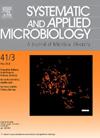Magnetovirga frankeli gen. Nov., sp. nov., a magnetotactic bacterium isolated from the Salton Sea, California, that represents a novel lineage in the Gammaprotoeobacteria
IF 4.2
2区 生物学
Q2 BIOTECHNOLOGY & APPLIED MICROBIOLOGY
引用次数: 0
Abstract
A magnetotactic bacterium, designated strain SS-5T, was isolated from the Salton Sea, a highly saline lake in California, USA, and cultivated in axenic culture. The Gram-negative cells of strain SS-5T are relatively small and rod-shaped and possess a single polar flagellum (monotrichous). This strain is a magnetotactic bacterium producing magnetite nanocrystals aligned in one chain per cell. Strain SS-5T is a microaerophile that grows chemolithoautotrophically while reducing oxygen as a terminal electron acceptor. Optimal growth occurred at pH 7.0–7.3 and 28–36 °C with thiosulfate used as an electron donor and sodium bicarbonate as a carbon source. Based on its genome sequence, the G + C content is 61.6 %. Phylogenomic and phylogenetic analyses indicate that strain SS-5T belongs to the Sedimenticolaceae family within the Gammaproteobacteria class. Based on average amino acid identity, strain SS-5T can be considered as a novel species of a new genus, for which the name Magnetovirga frankeli is proposed. The type strain of M. frankeli is SS-5T (=DSM 116211T = JCM 39467T).
frankeli Magnetovirga gen. Nov., sp. Nov.,一种从加利福尼亚索尔顿海分离出来的趋磁细菌,它代表了伽玛原细菌中的一个新谱系
从美国加州高盐湖Salton Sea中分离出一株趋磁细菌SS-5T,并进行无菌培养。菌株SS-5T革兰氏阴性细胞相对较小,呈杆状,具有单极鞭毛(单色)。这种菌株是一种趋磁细菌,每个细胞产生排成一条链的磁铁矿纳米晶体。菌株SS-5T是一种微亲氧菌,它以化学岩石自养的方式生长,同时作为终端电子受体还原氧。以硫代硫酸盐为电子供体,碳酸氢钠为碳源,在pH 7.0-7.3和28-36℃条件下生长最佳。根据其基因组序列,G + C含量为61.6%。系统发育和系统发育分析表明,菌株SS-5T属于伽玛变形菌纲中的沉积菌科。基于平均氨基酸特征,菌株SS-5T可视为一个新属的新种,并建议将其命名为Magnetovirga frankeli。M. frankeli型菌株为SS-5T (=DSM 116211T = JCM 39467T)。
本文章由计算机程序翻译,如有差异,请以英文原文为准。
求助全文
约1分钟内获得全文
求助全文
来源期刊

Systematic and applied microbiology
生物-生物工程与应用微生物
CiteScore
7.50
自引率
5.90%
发文量
57
审稿时长
22 days
期刊介绍:
Systematic and Applied Microbiology deals with various aspects of microbial diversity and systematics of prokaryotes. It focuses on Bacteria and Archaea; eukaryotic microorganisms will only be considered in rare cases. The journal perceives a broad understanding of microbial diversity and encourages the submission of manuscripts from the following branches of microbiology:
 求助内容:
求助内容: 应助结果提醒方式:
应助结果提醒方式:


